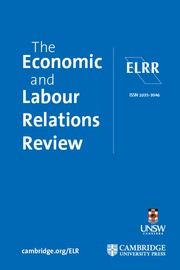Crossref Citations
This article has been cited by the following publications. This list is generated based on data provided by
Crossref.
Hardy, Tess
2011.
Enrolling Non-State Actors to Improve Compliance with Minimum Employment Standards.
The Economic and Labour Relations Review,
Vol. 22,
Issue. 3,
p.
117.
Vosko, Leah F.
Tucker, Eric
Gellatly, Mary
and
Thomas, Mark P.
2011.
New Approaches to Enforcement and Compliance with Labour Regulatory Standards: The Case of Ontario, Canada.
SSRN Electronic Journal,
Wise, Amanda
2013.
Pyramid subcontracting and moral detachment: Down-sourcing risk and responsibility in the management of transnational labour in Asia.
The Economic and Labour Relations Review,
Vol. 24,
Issue. 3,
p.
433.
Meléndez, Edwin J.
Visser, M. Anne
Theodore, Nik
and
Valenzuela, Abel
2014.
Worker Centers and Day Laborers’ Wages*.
Social Science Quarterly,
Vol. 95,
Issue. 3,
p.
835.
Johnstone, Richard
Nossar, Igor
and
Rawling, Michael
2015.
Regulating Supply Chains to Protect Road Transport Workers: An Early Assessment of the Road Safety Remuneration Tribunal.
Federal Law Review,
Vol. 43,
Issue. 3,
p.
397.
Hardy, Tess
and
Howe, John
2015.
Chain reaction: A strategic approach to addressing employment noncompliance in complex supply chains.
Journal of Industrial Relations,
Vol. 57,
Issue. 4,
p.
563.
James, Phil
Walters, David
Sampson, Helen
and
Wadsworth, Emma
2015.
Regulating the employment dynamics of domestic supply chains.
Journal of Industrial Relations,
Vol. 57,
Issue. 4,
p.
526.
Champlin, Dell P.
and
Knoedler, Janet
2017.
Contingent Labor and Higher Education.
Review of Political Economy,
Vol. 29,
Issue. 2,
p.
232.
Coslovsky, Salo
Pires, Roberto
and
Bignami, Renato
2017.
Resilience and Renewal: The Enforcement of Labor Laws in Brazil.
Latin American Politics and Society,
Vol. 59,
Issue. 2,
p.
77.
Adams, Ronald J.
2018.
Mcdonald’s versus NLRB: The End of Franchising, or an Overdue Restoration of Countervailing Power?.
Business and Society Review,
Vol. 123,
Issue. 4,
p.
601.
Koenig, Biko
2018.
Economic Inequality and the Violation Economy.
Poverty & Public Policy,
Vol. 10,
Issue. 4,
p.
505.
Crane, Andrew
LeBaron, Genevieve
Allain, Jean
and
Behbahani, Laya
2019.
Governance gaps in eradicating forced labor: From global to domestic supply chains.
Regulation & Governance,
Vol. 13,
Issue. 1,
p.
86.
Berry, Steven
Gaynor, Martin
and
Morton, Fiona Scott
2019.
Do Increasing Markups Matter? Lessons from Empirical Industrial Organization.
Journal of Economic Perspectives,
Vol. 33,
Issue. 3,
p.
44.
VALDEZ, INÉS
2020.
Reconceiving Immigration Politics: Walter Benjamin, Violence, and Labor.
American Political Science Review,
Vol. 114,
Issue. 1,
p.
95.
Helfen, Markus
Sydow, Jörg
and
Wirth, Carsten
2020.
Service Delivery Networks and Employment Relations at German Airports: Jeopardizing Industrial Peace on the Ground?.
British Journal of Industrial Relations,
Vol. 58,
Issue. 1,
p.
168.
Anselmann, Christina
2020.
Secular Stagnation Theories.
p.
253.
Albelda, Randy
Bell-Pasht, Aimee
and
Konstantinidis, Charalampos
2020.
Gender and Precarious Work in the United States: Evidence from the Contingent Work Supplement 1995–2017.
Review of Radical Political Economics,
Vol. 52,
Issue. 3,
p.
542.
Peters, Susan E.
Nielsen, Karina M.
Nagler, Eve M.
Revette, Anna C.
Madden, Jennifer
and
Sorensen, Glorian
2020.
Ensuring Organization-Intervention Fit for a Participatory Organizational Intervention to Improve Food Service Workers’ Health and Wellbeing.
Journal of Occupational & Environmental Medicine,
Vol. 62,
Issue. 2,
p.
e33.
Goldman, Tanya
and
Weil, David
2020.
Who’s Responsible Here? Establishing Legal Responsibility in the Fissured Workplace.
Institute for New Economic Thinking Working Paper Series,
p.
1.
Barba, Aldo
2020.
Domestic Outsourcing and Workers’ Bargaining Power in a Simple Production System.
Contributions to Political Economy,
Vol. 39,
Issue. 1,
p.
42.

